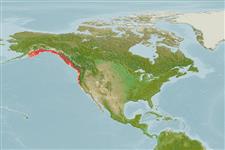Teleostei (teleosts) >
Perciformes/Scorpaenoidei (Scorpionfishes) >
Sebastidae (Rockfishes, rockcods and thornyheads) > Sebastinae
Etymology: Sebastes: Greek, sebastes = august, venerable (Ref. 45335); maliger: From the Greek malus meaning mast and gero meaning 'magnificent' and 'to bear' (Ref. 27436).
More on authors: Jordan & Gilbert.
Environment: milieu / climate zone / depth range / distribution range
Ecology
Marine; demersal; depth range 0 - 274 m (Ref. 27437), usually 0 - 92 m (Ref. 27437). Temperate; 61°N - 33°N, 163°W - 118°W
Eastern Pacific: From Shumagin Islands, Prince William Sound and Gulf of Alaska to San Miguel Island, southern California, USA.
Length at first maturity / Size / Weight / Age
Maturity: Lm 31.0 range ? - ? cm
Max length : 61.0 cm TL male/unsexed; (Ref. 2850); max. published weight: 3.3 kg (Ref. 40637); max. reported age: 90 years (Ref. 55421)
Dorsal
spines
(total): 13;
Dorsal
soft rays
(total): 12-14;
Anal
spines: 3;
Anal
soft rays: 6 - 7. Head spines strong - nasal, preocular, postocular, tympanic and parietal spines present, supraocular, coronal and nuchal spines absent (Ref. 27437). Spinous dorsal with deeply incised membranes (Ref. 27437). Caudal fin rounded (Ref. 6885). Body mottled brown, distinct yellow areas above (including part of spinous dorsal), orange-brown spotting on lower anterior area (Ref. 27437).
Inhabit rocky bottoms and reefs, usually solitary on the bottom or hovering just above the bottom, but never far from cover (Ref. 27436, 27437). Viviparous (Ref. 34817). Marketed as fillets (Ref. 27436).
Eschmeyer, W.N., E.S. Herald and H. Hammann, 1983. A field guide to Pacific coast fishes of North America. Boston (MA, USA): Houghton Mifflin Company. xii+336 p. (Ref. 2850)
IUCN Red List Status (Ref. 130435)
Threat to humans
Harmless
Human uses
Fisheries: commercial; gamefish: yes; aquarium: public aquariums
More information
ReferencesAquacultureAquaculture profileStrainsGeneticsElectrophoresesHeritabilityDiseasesProcessingNutrientsMass conversion
Tools
Can't connect to MySQL database fbquizv2. Errorcode: Too many connections
